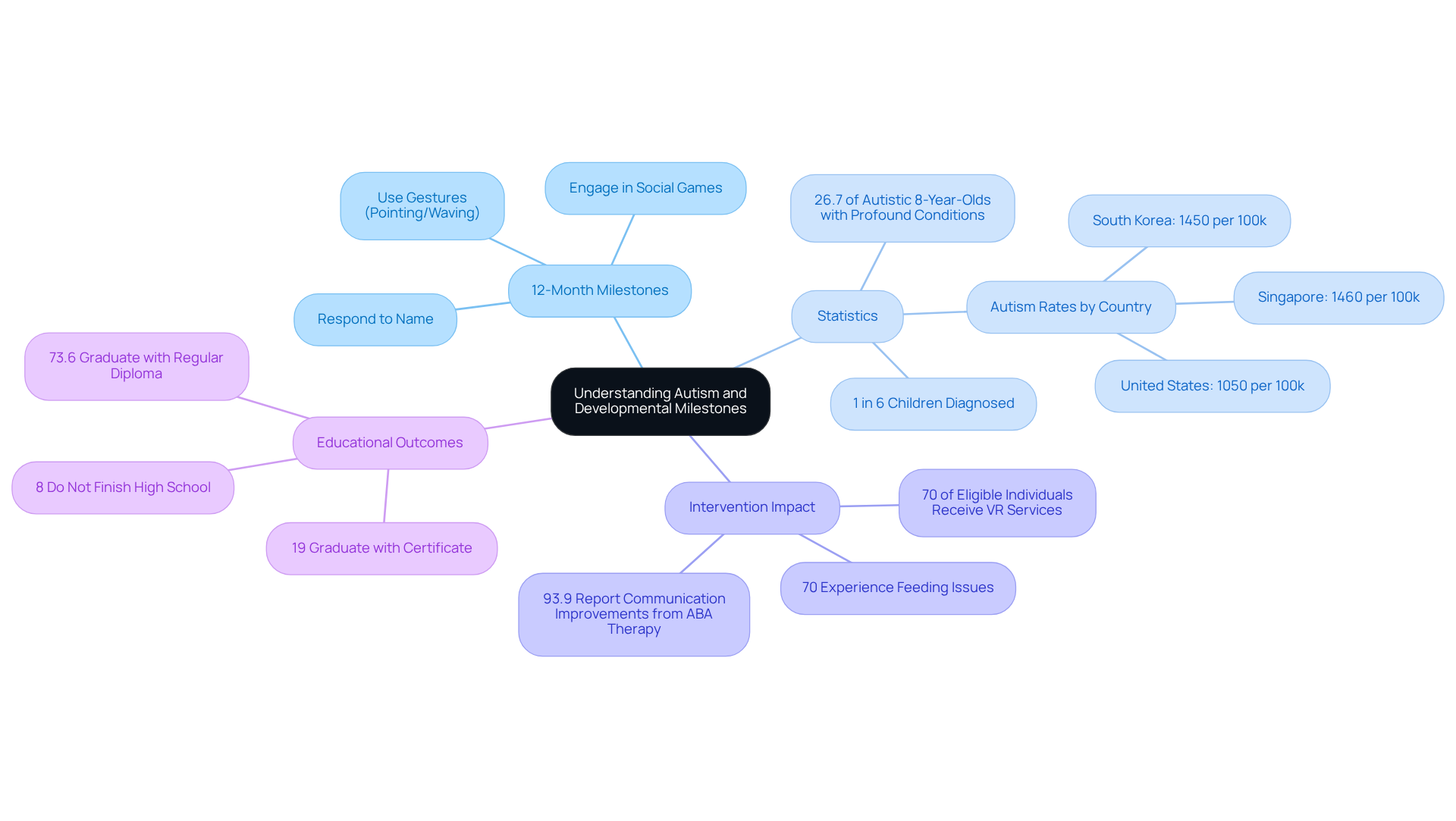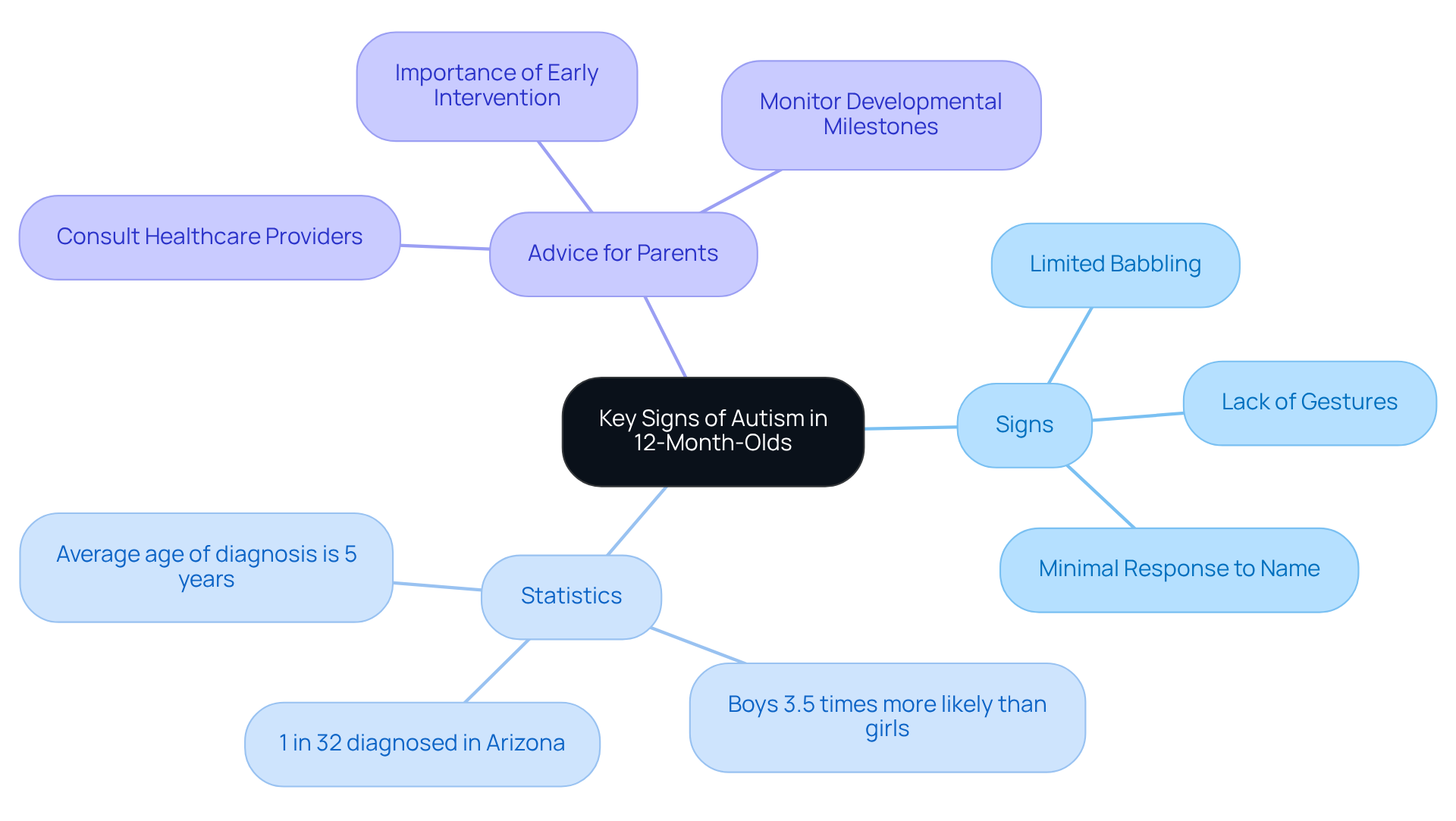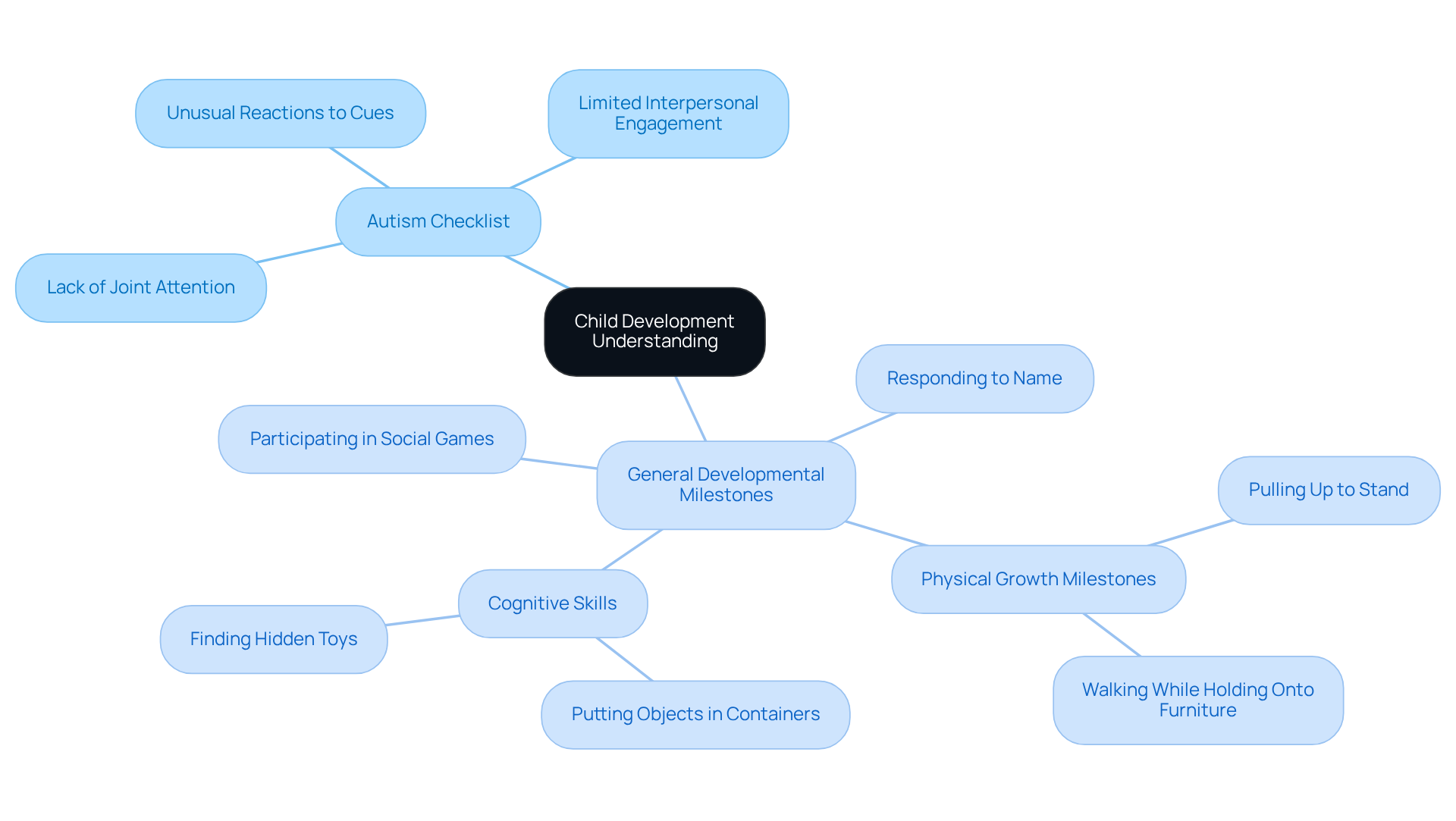Overview
This article highlights the significance of the 12-month autism checklist in relation to general developmental milestones, underscoring the vital role of early identification of autism spectrum disorder (ASD) in children. Understanding both frameworks is essential for parents, as it empowers them to recognize potential developmental delays. By doing so, they can seek timely intervention, which can greatly enhance long-term outcomes for their children with ASD. Every step taken towards awareness and understanding can make a profound difference in a child's life. Let's explore how we can support one another in this journey.
Introduction
The journey of understanding a child's development can be both enlightening and daunting, especially when it comes to the complexities of Autism Spectrum Disorder (ASD). As parents reach the critical 12-month milestone, they often find themselves faced with the challenging task of distinguishing between typical developmental progress and potential signs of autism. This article explores the nuances of the 12-month autism checklist in comparison to general developmental milestones, offering valuable insights into the behaviors to monitor and the crucial importance of early intervention.
With each passing month, the stakes rise—how can parents effectively discern these subtle indicators and ensure timely support for their child's growth? Your awareness and proactive approach can make all the difference in your child's development.
Understanding Autism and Developmental Milestones
Autism Spectrum Disorder (ASD) is a complex neurodevelopmental condition that can present challenges in interpersonal interaction, communication, and behavior. For parents, understanding developmental milestones is crucial, as these milestones serve as key indicators of a child's growth. By 12 months, for example, children are typically expected to:
- Respond to their names
- Engage in social games
- Use gestures like pointing or waving
These expectations are outlined in the 12-month old autism checklist. Recognizing these milestones can help identify potential setbacks or atypical development associated with the 12-month old autism checklist.
The CDC outlines specific milestones that children should reach by certain ages, providing a standard for evaluating their development. Understanding the connection between ASD and these milestones is vital for early identification and intervention, which can significantly improve outcomes for children with ASD. Current statistics reveal that approximately 1 in 6 children aged 3 to 17 are diagnosed with a developmental disability, highlighting the prevalence of such conditions.
Moreover, 26.7% of autistic 8-year-olds in the U.S. experience profound conditions, illustrating the varying degrees of severity within the spectrum. While the typical age for an autism diagnosis is currently around 4 years, there are recommendations for screening at 18 and 24 months, underscoring the need for timely action. Pediatricians emphasize that early recognition of developmental milestones can lead to earlier interventions, ultimately enhancing the quality of life for affected children.
It’s also important to note that many children diagnosed with ASD face additional challenges, such as eating and feeding problems, with 70% experiencing these issues. Furthermore, 93.9% of parents and caregivers have reported improvements in their child's communication skills due to ABA therapy, showcasing the positive impact of targeted interventions. Finally, it’s encouraging to see that 73.6% of autistic high school students in the U.S. graduate with a regular diploma, reflecting positive educational outcomes.
As we navigate this journey together, sharing experiences and resources can help foster a supportive community for families affected by ASD.

Key Signs of Autism in 12-Month-Olds
At 12 months, parents may use a 12-month old autism checklist to notice key signs of developmental disorders, such as:
- Limited or absent babbling
- A lack of back-and-forth gestures like pointing or waving
- Minimal response to their name
It's important to understand that boys are 3.5 times more likely than girls to be identified with autism. According to Autism Speaks, children may also show reduced interest in social interactions, often preferring objects over people. These subtle signs are crucial for parents to monitor closely with the 12-month old autism checklist.
The CDC emphasizes that neglecting these early signs, as outlined in the 12-month old autism checklist, can lead to delays in diagnosis and action, which are vital for improving developmental outcomes. In the U.S., the typical age of diagnosis is 5 years, with the initial procedure generally occurring at 4.7 years. Statistics reveal that approximately 1 in 32 youngsters in Arizona were diagnosed with autism in 2022, underscoring the importance of vigilance.
If you observe these signs, it’s encouraged to consult healthcare providers who can guide you through the 12-month old autism checklist. Early intervention can significantly enhance communication and social skills, paving the way for better long-term outcomes. Additionally, free developmental screenings are available for parents who have concerns about their child's development. Dr. Smith notes that subtle variations in eye gaze can be detected in the first year of life, even before noticeable signs of developmental disorders emerge.
As a parent, staying informed and proactive can make a meaningful difference in your child's journey. Your observations matter, and seeking guidance can lead to positive changes.

Comparing Autism Checklist with General Developmental Milestones
As parents, understanding your child's development is crucial, especially as they reach the 12-month mark. The 12-month old autism checklist highlights behaviors that may indicate a developmental disorder, such as a lack of joint attention and limited interpersonal engagement. In contrast, general developmental milestones cover a broader range of skills, including physical, cognitive, and social-emotional growth. For example, while both frameworks recognize the importance of interpersonal engagement, the checklist specifically highlights unusual reactions to cues from others.
The CDC outlines key milestones, such as responding to their name and participating in simple social games—these are essential for typical development. It's important to note that autism can often be identified by age 2; however, the average diagnosis age in the U.S. is 5 years, with children from lower-income families diagnosed around 4.7 years. By comparing these two frameworks, you can gain a deeper understanding of your child's development, which enables you to seek focused assistance when needed.
Moreover, the CDC's Milestone Tracker App serves as a valuable resource for tracking your child's developmental progress efficiently. Development experts emphasize that understanding both the overall developmental milestones and the 12-month old autism checklist is vital for early detection and support. If you have concerns about your child's development, consider exploring these resources and connecting with professionals who can guide you on this journey.

Importance of Early Intervention and Next Steps
Timely support is essential for children diagnosed with autism, significantly enhancing their developmental journey. Research consistently shows that the earlier a young person receives assistance, the more positive their outcomes in communication, social skills, and behavior management. For instance, studies reveal that children who engage in early support programs, like the Early Start Denver Model (ESDM), can experience an average IQ increase of 17 points along with improved adaptive behavior. Additionally, those receiving early help are less likely to require support services later in life, highlighting the long-term benefits of prompt intervention.
Parents are encouraged to reach out to healthcare professionals as soon as they notice signs of developmental disorders, such as delayed communication or limited social interaction. Early evaluations can lead to effective support strategies tailored to each child's unique needs.
Resources like Applied Behavior Analysis (ABA) therapy, speech therapy, and social skills training have been shown to effectively address the challenges faced by children with autism. A case study involving a young boy named Ethan illustrates this well; after participating in an ABA-focused early support program, he reduced his outbursts by 70% and began using short phrases to communicate within a year. This underscores the significant impact that early support can have on a child's development. Moreover, over 80% of families report improved quality of life and reduced stress levels after participating in early support programs, further emphasizing the positive effects on family dynamics.
ASD Media encourages parents to connect with local support groups and professionals to navigate the complexities of autism diagnosis and assistance. Embracing personalized approaches is crucial, as each child's strengths and needs are distinct. By taking proactive steps, parents can foster a nurturing environment that supports their child's growth and development, ultimately leading to better long-term outcomes. The commitment to early intervention not only enhances individual development but also contributes to a more inclusive society where children with autism can thrive.
Conclusion
Understanding the nuances between the 12-month old autism checklist and general developmental milestones is essential for parents navigating their child's growth. Recognizing the specific signs associated with Autism Spectrum Disorder (ASD) at this early age can significantly influence the effectiveness of interventions, ultimately shaping a child's developmental trajectory. By being vigilant and informed, parents can ensure they are equipped to advocate for their child's needs.
Throughout this article, we have shared key insights regarding the importance of monitoring developmental milestones and understanding the specific indicators of autism. The 12-month old autism checklist highlights critical behaviors that may signal atypical development, such as limited social engagement and delayed communication. Additionally, the comparison with general developmental milestones illustrates that while both frameworks aim to assess growth, the autism checklist focuses on behaviors that might be overlooked in standard evaluations. Early intervention has been shown to yield substantial benefits, enhancing communication skills and overall quality of life for children diagnosed with ASD.
Ultimately, the message is clear: early recognition and proactive engagement are vital. Parents are encouraged to utilize resources like the CDC's Milestone Tracker App and to seek guidance from healthcare professionals if they observe any signs of developmental concerns. By fostering a supportive environment and embracing early intervention strategies, families can help their children thrive, paving the way for a brighter future. The commitment to understanding and addressing autism not only benefits individual children but also enriches the community, promoting inclusivity and understanding for all.
Frequently Asked Questions
What is Autism Spectrum Disorder (ASD)?
Autism Spectrum Disorder (ASD) is a complex neurodevelopmental condition that can present challenges in interpersonal interaction, communication, and behavior.
Why is understanding developmental milestones important for parents?
Understanding developmental milestones is crucial for parents as these milestones serve as key indicators of a child's growth and can help identify potential setbacks or atypical development.
What are some developmental milestones expected by 12 months of age?
By 12 months, children are typically expected to respond to their names, engage in social games, and use gestures like pointing or waving.
How does the CDC contribute to understanding child development?
The CDC outlines specific milestones that children should reach by certain ages, providing a standard for evaluating their development and helping in early identification of issues.
What is the significance of early identification and intervention for children with ASD?
Early identification and intervention can significantly improve outcomes for children with ASD, enhancing their quality of life.
What statistics highlight the prevalence of developmental disabilities?
Approximately 1 in 6 children aged 3 to 17 are diagnosed with a developmental disability, indicating the commonality of such conditions.
What percentage of autistic 8-year-olds in the U.S. experience profound conditions?
About 26.7% of autistic 8-year-olds in the U.S. experience profound conditions, illustrating the varying degrees of severity within the spectrum.
When is the typical age for an autism diagnosis, and when are screenings recommended?
The typical age for an autism diagnosis is around 4 years, with recommendations for screening at 18 and 24 months.
What challenges do many children diagnosed with ASD face?
Many children diagnosed with ASD face additional challenges, such as eating and feeding problems, with 70% experiencing these issues.
How effective is ABA therapy for children with ASD?
Approximately 93.9% of parents and caregivers have reported improvements in their child's communication skills due to ABA therapy.
What percentage of autistic high school students in the U.S. graduate with a regular diploma?
About 73.6% of autistic high school students in the U.S. graduate with a regular diploma, reflecting positive educational outcomes.
How can families affected by ASD foster a supportive community?
Sharing experiences and resources can help foster a supportive community for families affected by ASD.




